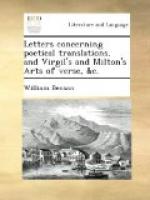VII. The changing the common Pronunciation of Words, as thus:
"Fluvi[)o]rum Rex Eridanus.—
And
"Strid[)e]re apes utero & ruptis efferv[)e]re costis.
VIII. Lines contrary to the common Measure, or rather without any Measure at all, viz.
“Quod fieri ferro, liquidove
potest electro,
Saxa per & scopulos & depressas convalles.
IX, X, XI. These are the three Articles formerly mentioned, namely, the Alliteratio, the Allusio Verborum, and the Assonantia Syllabarum.
1. As to the Alliteratio. This is of several Kinds, it is Initial, Single and Double; sometimes Treble, or more frequent. It is likewise Mix’d, that is, both in the first Letters of the Words, and in the following Syllables. It is sometimes so often repeated, that it may be term’d Assultus, or an Attack upon, or a storming of the Ear.
The following are Examples of the Single Alliteratio.
“Quid faciat laetas segetes,
quo sidere terram
Vertere, Maecenas, ulmisque
adjungere vites,
Conveniat: quae cura boum,
qui cultus habendo.
Again,
“—Sed viva volare
Sideris in numerum.—
And,
“—Asia longe
Pulia palus.—
Of the Double initial Alliteratio, this is an Example:
“Totaque thuriferis Panchaia pinguis arenis.
Of the Treble and more frequent initial Alliteratio, this is an Instance:
“Et sola in sicca secum spatiatur arena.
The Mix’d Alliteratio, and the Assultus are to be found in these two Lines:
“Illas ducit amor trans Gargara,
transque sonantem
Ascanium: superant montes,
& flumina tranant.
In these two Lines the Vowel a is repeated fourteen times, and what an Effect this has upon the Ear, the Reader cannot but perceive.
2. Of the Allusio Verborum, the following are Examples:
“Nec nocturna quidem carpentes pensa puellae.
Again,
“Hoc metuens; molemque & montes insuper altos.
Again,
“Stat sonipes, ac frena ferox spumantia mandit.
Again,
“Vitavisse vices Danaum.
3. Of the Assonantia Syllabarum or Rhyme, there are in Virgil the several following Sorts.
1. The plain direct Rhyme, which is of two Kinds, Single or Double.
2. The intermediate or casual plain Rhyme.
3. The scanning conclusive Rhyme. So called, because it would hardly be perceived by the Generality of Readers, unless they first scann’d the Verse; but when they have done that in three or four Lines, the Ear will afterwards make the necessary Distinction without any farther trouble.




